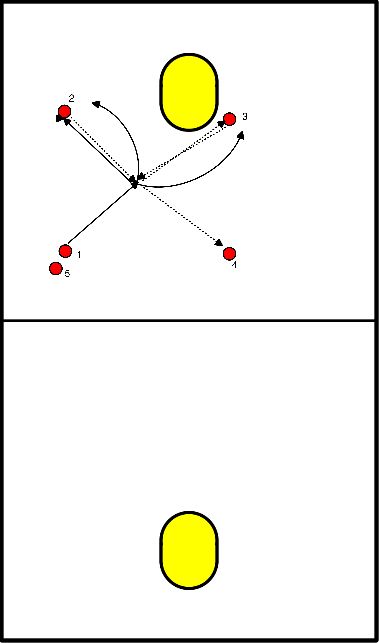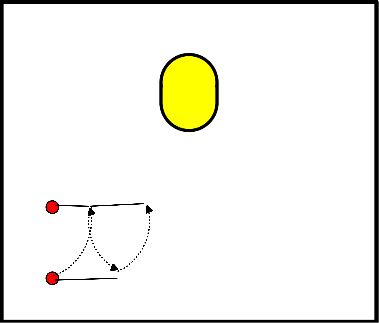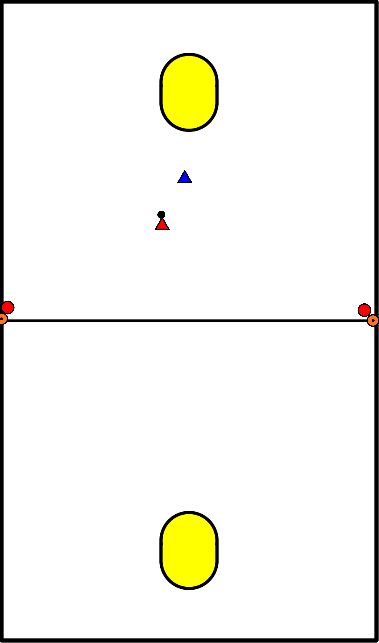Korfball exercises for u13
- 1 runs towards 3 and gets the ball from 2 and throws it to 3 and runs with a bow to the place of 2.
- 2 runs towards 4 and gets the ball from 3, throws to 4 and takes the place of 3.
- 3 runs towards 5 and gets the ball from 4 etc.

- We make 2 rows of 5.
- One row is next to each other at a distance of 2 meters, the other row is opposite at about 10 meters.
- You throw the ball to each other with one hand, sometimes with the left, sometimes with the right.
- The ball must be tight.
- Throw with each hand 25 times.
- Then you run towards the ball, which is played to you at 5 metres too high.
- You have to jump to catch the ball.
- Play the ball back to the other player in the jump.
- You both do this 15 times.
- Two rows of five opposite each other, about ten meters, with a mutual distance of two meters.
- You throw the ball with your right to the right side of your fellow player, who catches with his right and throws the ball to your right hand.
- You catch the ball with one hand. Do this 25 times with the right and 25 times with the left.
- Then you run towards your team-mate and, from five metres, the ball is passed to your right arm.
- Catch, jump up and place back.
- Do this 15 times with the right and 10 times with the left.
- You stand about seven metres apart.
- You play the ball to the player who is running away, she catches it and you pass her to the other side and back.
- The first time you do that with two hands, the second time you throw back with the outside hand.
- That means you throw with the right hand one time and with the left hand the next time and on the way back the other way around.

- Make a circle at the level of your head on the wall (with sidewalk chalk)
- Make the circle about the same size as a basket.
- Now stand 3 or 4 meters away from the circle.
- Now throw the ball with your left against the wall and catch it with your right hand.
- Do this for one minute.
- The ball must not bounce on the ground.
- If it is too easy, stand further away or try to throw the ball faster. If the exercise is too difficult, try to catch the ball with two hands, but still throw with one hand
- Or stand a little closer to the wall. (Outdoors exercise)
- We're gonna pass as a group.
- We stand in two rows opposite each other.
- We'll start as follows:
- Pass with two hands, catch with two hands.
- Pass with your good hand, catch with two hands.
- Pass with your good hand, catch with your good hand.
- Pass with the lesser hand, catch with two hands.
- Pass with your lesser hand, catch with your right hand.
- With the whole team, catch and throw well, if you don't do this and the ball falls to the ground 5 times.
For variation, you can also add special ways of throwing (behind the back, through legs, etc.)
- You have two attackers on the side in the middle between two baskets.
- The attacker must try to score with the help of the two players.
- At an interception, the defender becomes the attacker.
- When a goal is scored, the attacker gets a bonus and is allowed to keep attacking, only now he has to attack the other basket.
- When three goals have been scored, the winning attacker is rested and exchanged with a declarer.

In short: practicing various shooting variants in a fun competition form.
- Organization: per group a basket and a ball, the baskets are preferably (but not necessary) arranged in a circle or rectangle.
- The number of persons per group is less important (but all groups are about the same size).
- The first assignment for the groups is: score 10 goals.
- When you have completed this assignment, the person who scored the last goal runs to the trainer to pick up the next assignment.
- Which group completed all assignments first?
- The trainer walks around, encouraging, or correcting.
- He has a piece of paper with him with a row of assignments on it.
- When someone comes to pick up the next assignment, first ask which one has just been done (this can vary considerably over time) and then hand out the next assignment.
- An example list: 10 walk-through balls, 15 penalty shots, 5 8-meter shots, 10 walk-through balls from behind the basket, 5 dodge balls next to the pole, 10 6-meter shots.
- Everything is possible of course, a lot of momentum is gained if the number of goals to be scored is kept small.
- 10 walk-through balls
- 20 small oppertunities
- 6 remote shots
- 10 penalty throws
- 1 backwards
- Three at a basket
- Two shooters in front of the basket at shooting distance 4-6 metres, one rebounder under the basket.
- The shooters take turns shooting, whoever scores first can stay at the basket.
- The losing shooter changes to the rebounder and the new battle begins.
- Option: The shooter who scores three goals first may remain standing.
- Option: In foursomes, you have two teams (one shooter, one rebounder), the losing team switches positions between them.
- Triplets under the basket
- No. 1 shoots from under the basket
- No. 2 catches the ball and shoots from under the basket (there where she/he catches the ball)
- No. 3 catches the ball .........
- Nr. 1 catches the ball ......... etc.
- Whichever team has scored 30 goals first.
- Option, when the ball falls to the ground 1 point deducted from the goal score, less than 0 is not possible.
- With groups together.
- The first of the groups will walk around the room, walk to the basket and make a shot from 4 meters.
- As soon as this one is seated, walk to the next one.
- Number 2 also makes a round, walks to the basket and makes a through ball, the third a short chance behind the basket, the fourth a shot behind the basket.
- Then all 4 players take a staff throw and sit down.
- Who is first with the whole group at their basket has won
- 4 against 4.
- Pay attention to the basic set-up, to the ball pace and to the movement of the players, so that there is not just one attacker moving.
- Make the game more surprising by moving the ball, pulling the ball away, throwing it deep, etc.








